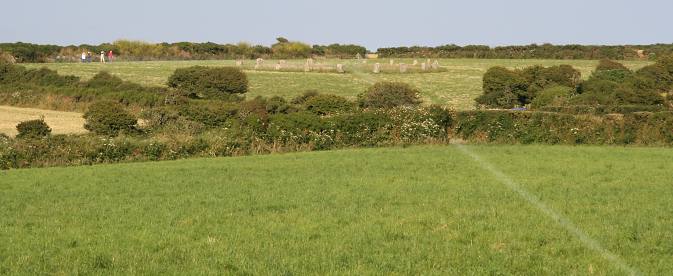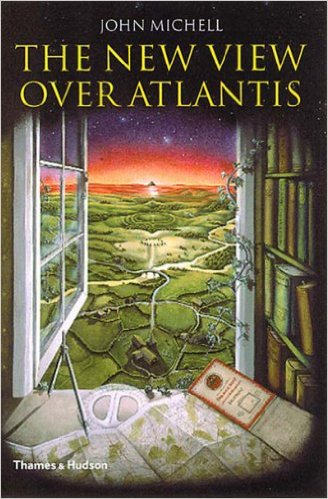The Dream....
You look out across the ancient landscape. from a standing stone. Out in the distance you spy a stone circle, from a faint shift in your inner vision you see it all before you, including the faint lines of ancient energy linking the sites across the landscape.

a ley line
There is something beautifully compelling about the idea of ley lines - straight lines of energy only perceptible by ethereal vision linking key sites of great antiquity, a network of invisible energy set in train by early humans who lived in far closer harmony with the land that we can even imagine.
The myth
So much great myth is contained in the ley line theory, particularly as amplified in the 1970s. At the most basic level there is the European myth of the noble savage from Victorian empire days, which runs deep in British culture. The idea took off because it was attractive and resonated on many levels - a reaction to the deracination felt by many people in a technological civilisation that achieved most of its great works and its strength by the power of analytic thought rather than intuitive grasp. There is the myth of the wisdom of an ancient race that knew far more than us in areas we have forgotten, and could shape forces our instruments are too crude to measure coupled with the poignancy of the assumed decline and fall.

The book cover from John Michell's "New View over Atlantis" gives a feel of the ley-line vision
It is the tradition of the Greek myth of Atlantis writ for the 20th century, and the enchanted Golden Age of the Christian story of Eden and the Fall from Grace. Indeed one of the seminal works was called A View over Atlantis, written by John Michell, a key ley proponent in the 1970s. As if all that isn't enough, there is a heady dose of the spirit of the monolith of Arthur C Clarke's 2001 - recast in the large stones standing sentinel across the lonely moors of the British Isles, established by the wise Ancient Ones, watching, waiting across the windswept millennia, guiding these fine energies, until a trigger is received and the time is come for the message from antiquity to be revealed - a myth resonant of the death of Arthur, once and future king of Britain, and indeed one of the core tenets of Christianity in the Second Coming. It then got an injection of 1960s white heat of technology optimism -
So by the end of the 1960s, the new young generation of ley hunters felt that leys were probably lines of energy, of magnetism even, and associated the lines with UFOs and psychic experience. The ley theory had become as brightly coloured as a 1960s psychedelic shirt,and would hardly have been recognised by Alfred Watkins. Paul Devereux
According to Paul Devereux, some of the 1960s ley lines as energy lines was propagated by an ex-RAF pilot, Tony Wedd. Before GPS came in the 1980s air navigation would sometimes use ADF to follow a straight line on NDB radio beacons, perhaps some of this crosstalked to the Earth Mysteries culture of the 1960s in the same way as the space race fed into UFOs which were big at the time.
The reality
Part of the attraction of standing stones and megalithic sites is the counterpoint between their undeniable and massive physical presence, set against their essential mystery. They are definitely there, and many of us have verified that with our very own senses, and they were clearly put there at great effort implying a good reason to put them there. That reason is lost in the mists of prehistory, but that it existed speaks down the millennia.
Ley lines not only provide a possible reason, but also supplies a framework linking the different sites together, and a low cost opportunity for anybody to make new discoveries with a minimum of outlay. The subject was the nature of a battle in the 1970s between the archaeological establishment and the alternative theorists. Although I had wandered the stones of Stonehenge as a child in the mid Seventies, I first discovered the appeal of standing stones when touring some of the sites in a friend's camper van a decade later. The difference between the earth mysteries literature from the seventies compared to that of the 1990s was stark. I'd always wanted to know what had gone on, and why the mention of the subject seemed to cause lots of shuffling and even repudiations such as Danny Sullivan's 3rd Stone article from 1997.
The 1970s newsletter 'The Ley Hunter' has been put on the web at http://www.tlh6976.fsnet.co.uk/ by Jim Goddard, the original editor of the newsletter. The story is a great romp of passion, bad temper and name-calling from both sides - I never realised the two camps had such fun trashing each other!
A lot of things make ley hunting easier now than it was in the 1970s - in particular drawing lines on computer maps is no longer as destructive as it is on paper maps. However, the issues turned out to be with the intuitive inference that if a straight line could be drawn through more than four sites it was likely to be intentional. Paradoxically, though ley hunters lost the battle comprehensively with the 1983 publication of Tom Williamson and Liz Bellamy's "Ley Lines in Question", one could argue the archaeological concept of the ritual/sacred landscape is a more general case of the idea that more can be learned by taking a group of sites as a whole.
Modern archaeology takes far more regard for the need of sites to be operating at the same time, contrasted with the ley hunter easy-going use of churches on the same ley as prehistoric sites. This was an inference of the general from the particular. Some churches had been built on earlier pagan sites. Not all had.
One can't dismiss the appealing ley system with its magical energy lines and ancient wisdom out of hand however - here is a extract of the epic battle from the 1970s, readable both for the combative and bad-tempered approach of the ley hunters and their opponents and also a worked example of a set of leys in Cornwall proposed by John Michell as proof of the theory at the time.
Wakening from the dream: Ley lines in Question
